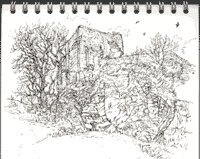|  At
last, a decent day, so I've come to Cavedale, Castleton.
While I'm drawing the medieval castle, I look down and see a sharply defined
pattern of concentric rings in a fragment of limestone at my feet. At
last, a decent day, so I've come to Cavedale, Castleton.
While I'm drawing the medieval castle, I look down and see a sharply defined
pattern of concentric rings in a fragment of limestone at my feet.
Later, I e-mail my field sketches to a geologist friend who tells me
that 'the flat shell looks like a spirifer but I am not
sure about the +ve and -ve shells.'
' The mineral is interesting,' she says, 'If you could scratch it with
a fingernail then it was probably gypsum not calcite
which is odd. But I have found some strange minerals in Castleton - it
is famous for them.'
 Life on the Reef
Life on the Reef
I must go back and take a closer look at the minerals. I always find
the fingernail test hard to judge. Is the fingernail really scratching
the mineral or is the mineral scraping the fingernail, leaving a white
mark on the mineral? Calcite is the most likely, so perhaps I was mistaken.
Calcite would scratch with a knife but not with a fingernail.
I think both species of fossils are brachiopods (of
which Spirifer was a species), a creature with a thick shell
with hinged valves, not related to the sea shells that we're most familiar
with, which are molluscs.
If I'd been here 320 million years ago I would have been, as I understand
it, in a surge channel at the edge of a reef. The castle stands on the
top of the reef. To the south there was a tropical lagoon (Britain was
on the equator at the time), while to the north, in a similar topography
to that seen today, there was deeper water.
 From
the north a river delta was advancing, as grit, sand and mud poured into
the sea, washed down from a mountain chain that stood where the Scottish
hills stand today. From
the north a river delta was advancing, as grit, sand and mud poured into
the sea, washed down from a mountain chain that stood where the Scottish
hills stand today. 
Richard Bell, richard@willowisland.co.uk
|